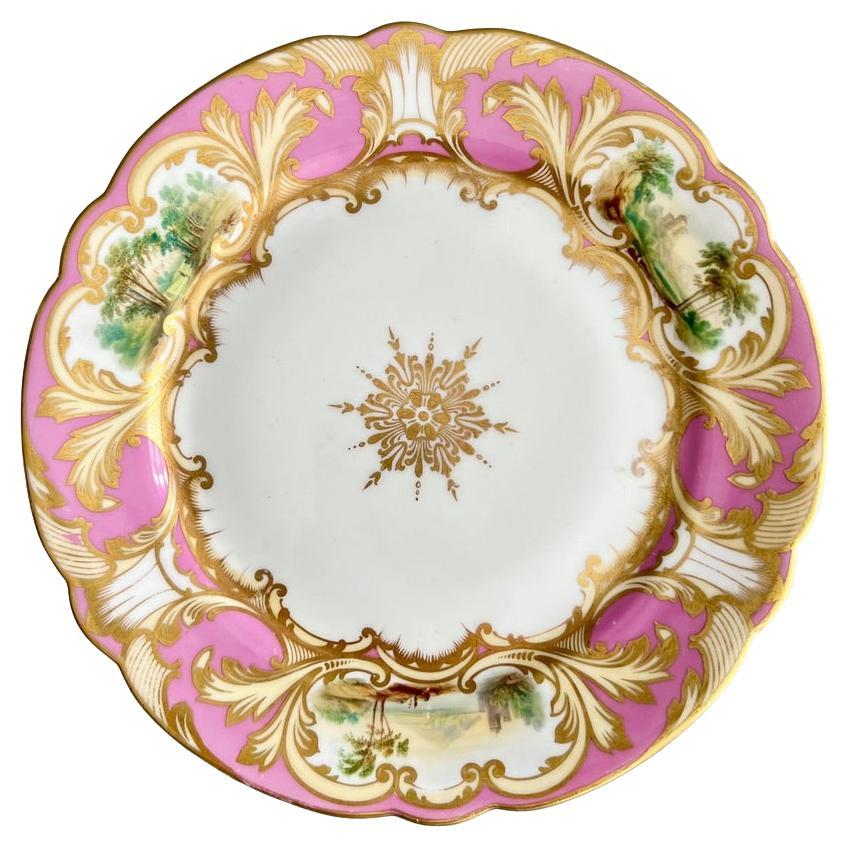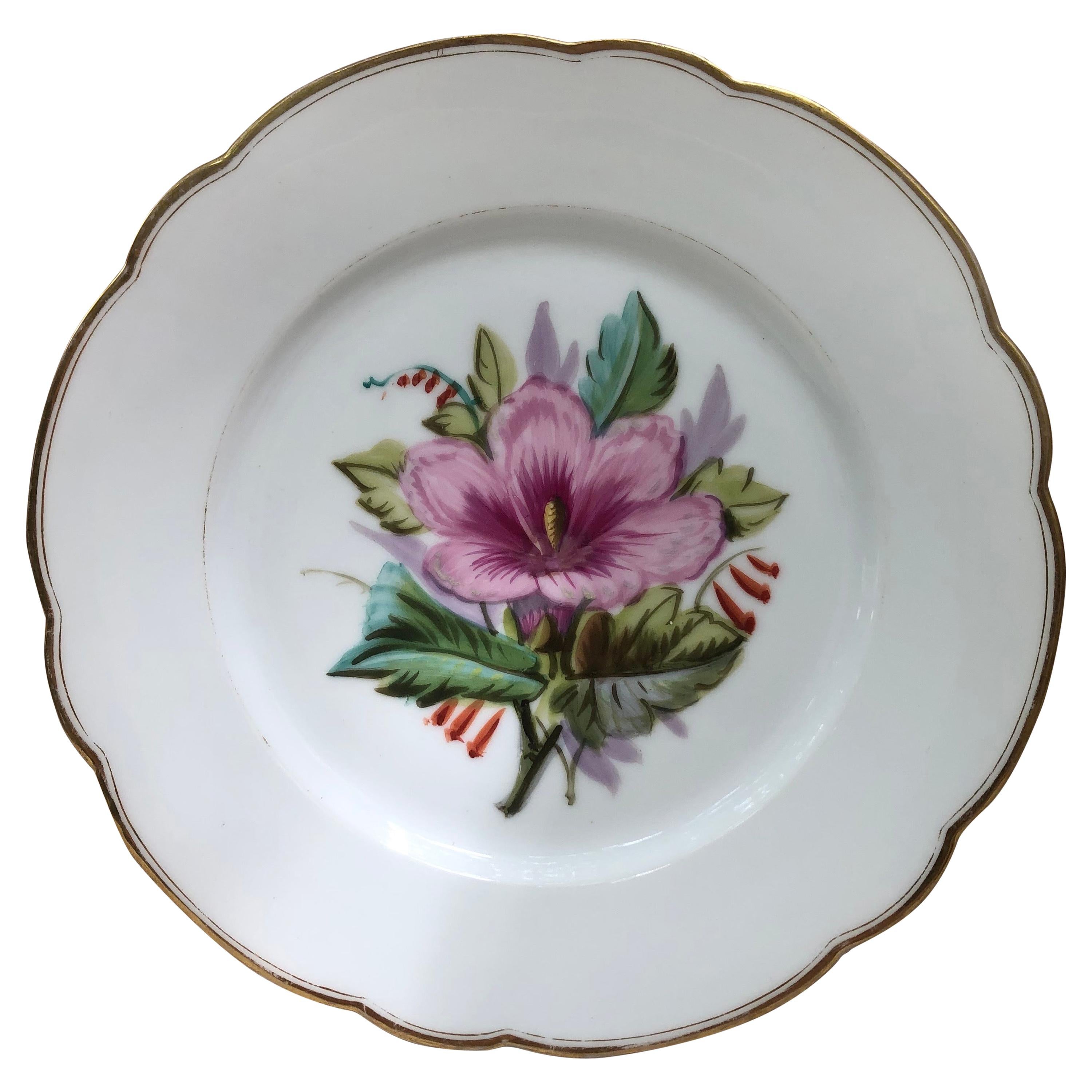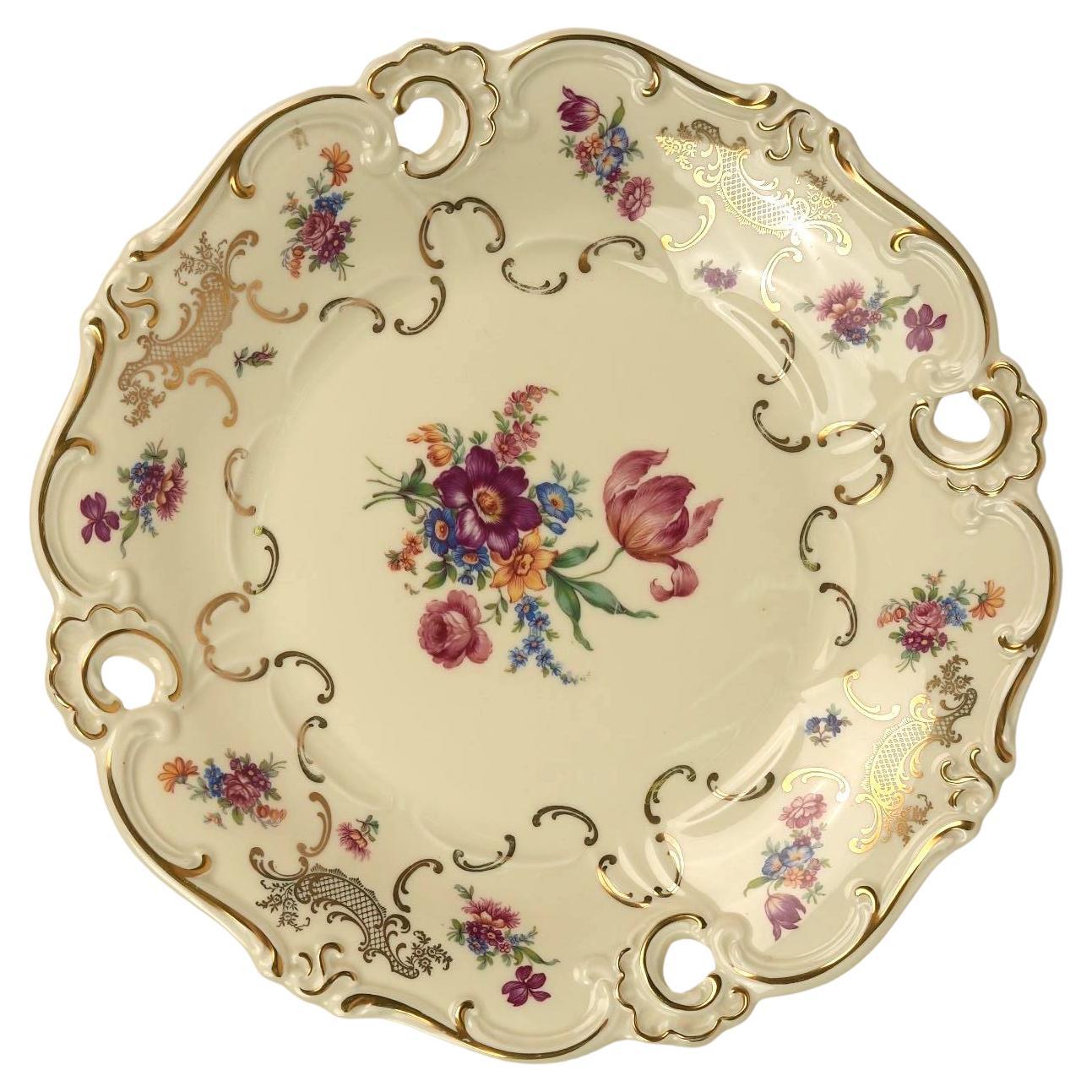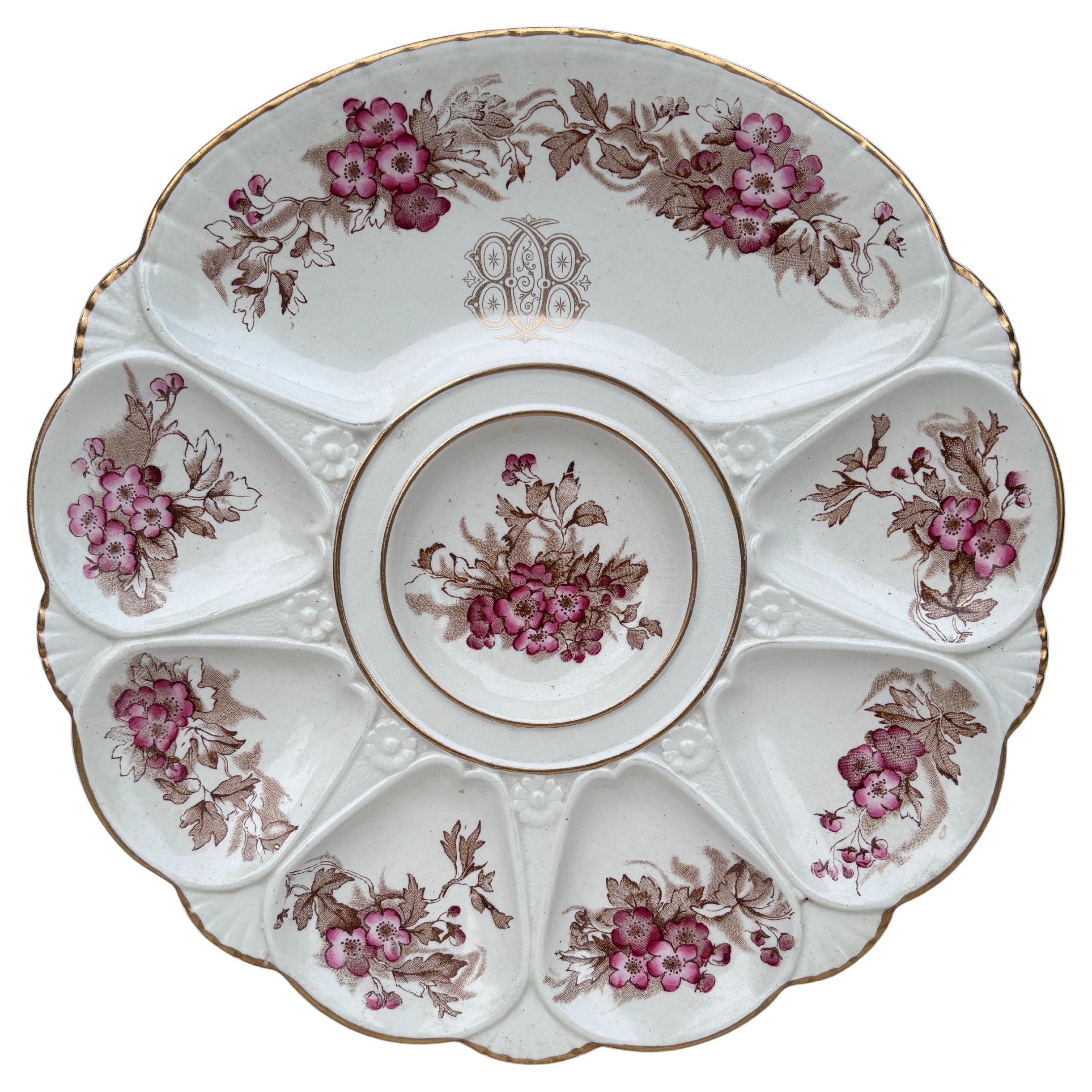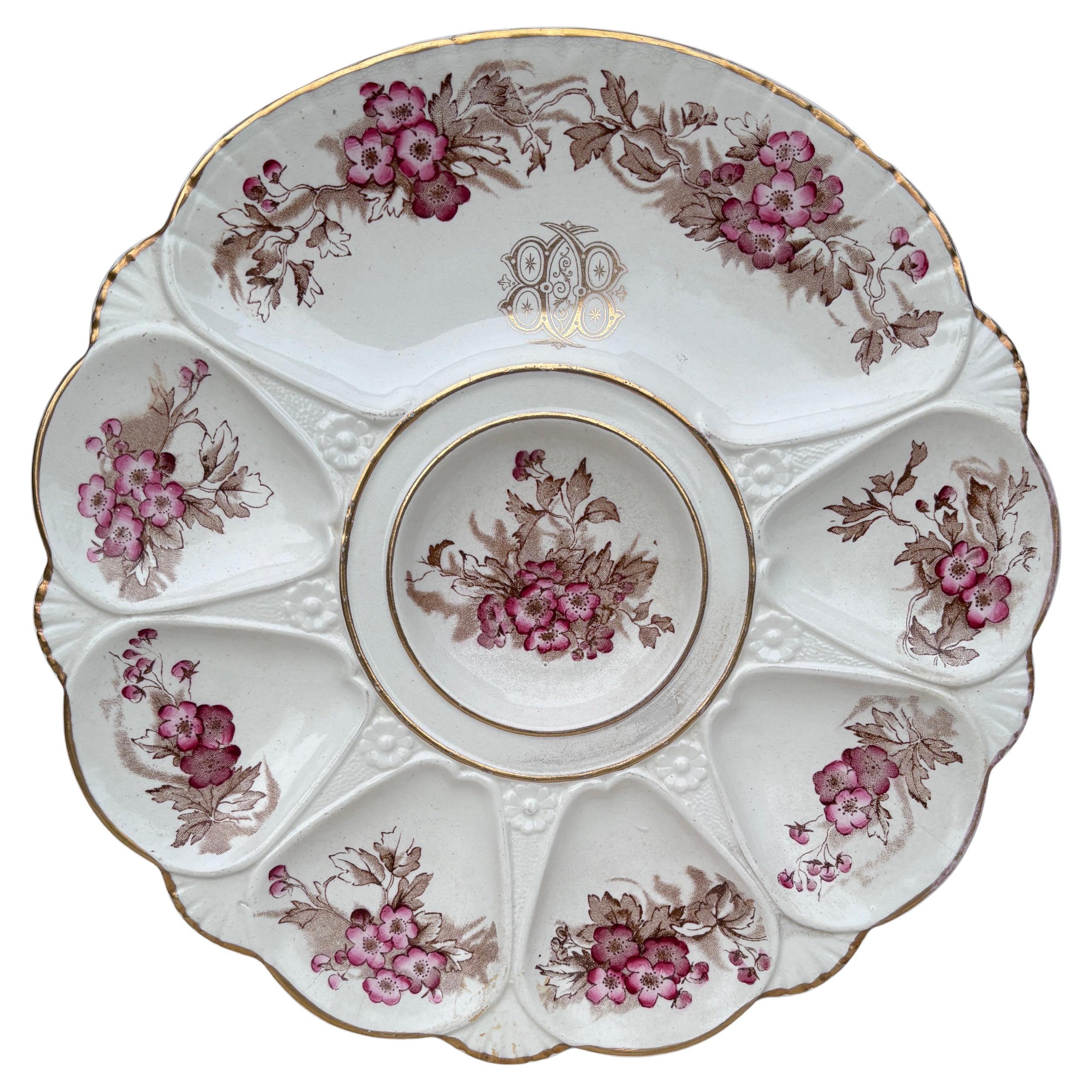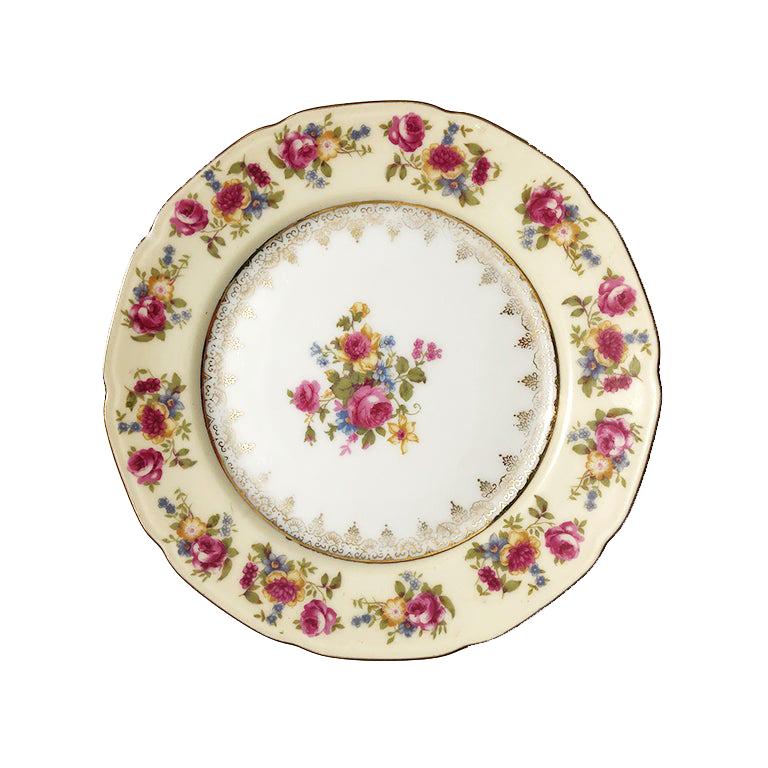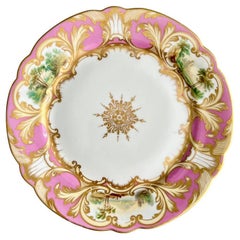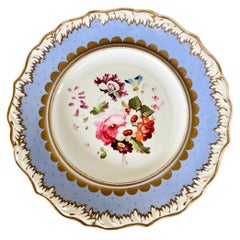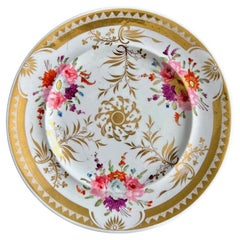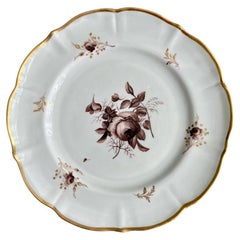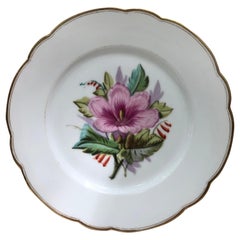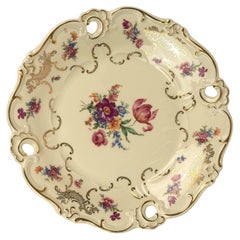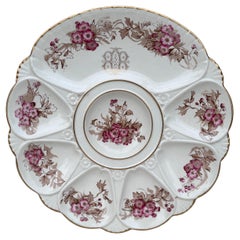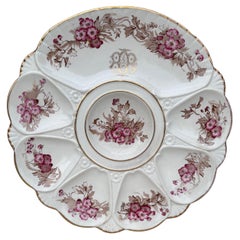Items Similar to Samuel Alcock Plate, Grey and Beige Acanthus Border, Pink Flower, ca 1835
Want more images or videos?
Request additional images or videos from the seller
1 of 13
Samuel Alcock Plate, Grey and Beige Acanthus Border, Pink Flower, ca 1835
$340
$42520% Off
£257.98
£322.4820% Off
€294.98
€368.7320% Off
CA$474.89
CA$593.6120% Off
A$528.01
A$660.0120% Off
CHF 275.70
CHF 344.6220% Off
MX$6,427.18
MX$8,033.9720% Off
NOK 3,517.79
NOK 4,397.2320% Off
SEK 3,296
SEK 4,12020% Off
DKK 2,201.50
DKK 2,751.8820% Off
Shipping
Retrieving quote...The 1stDibs Promise:
Authenticity Guarantee,
Money-Back Guarantee,
24-Hour Cancellation
About the Item
This is a beautiful plate with a warm grey and beige border of flowing acanthus leaves and pebble design with elaborate gilt, and a beautiful pink flower in the centre.
Pattern: 8107
Year: ca 1835
Size: 23.5cm (9.25") diameter
Condition: excellent without damage, repairs or crazing, just some light wear and some light soot baked into the back of the plate
Provenance: The Murray Pollinger Collection
The Samuel Alcock factory was operative in Staffordshire between 1822 and 1856, after which it was bought by Sir James Duke and Nephews. The factory started as a partnership between the young Samuel Alcock and the older Ralph Stevenson, who provided the factory and capital. Alcock quickly took the factory to great heights, building one of the biggest factories of its time. Alcock jumped on the new Rococo Revival fashion and served a huge new middle class market. The reason we now don't hear much about Samuel Alcock porcelain is that much of it has been mis-identified over the years and attributed to Coalport, Ridgway, Rockingham or others; Alcock did not mark any of his porcelain save a few rare pieces, and the numbering system is difficult to understand. However, the wares are still wide spread and many are of great quality.
This plate formed part of the Murray Pollinger Collection of Samuel Alcock Porcelain.
Murray Pollinger was a passionate collector of Samuel Alcock porcelain. He was known as a true gentleman, impeccably dressed, always kind and modest - even some of his porcelain collecting friends had no idea about the size and importance of his collection. From the mid 1980s until shortly before his death in 2022 he collected many thousands of pieces and painstakingly catalogued them. He also went on trips to Staffordshire to discover the history of Samuel Alcock from whatever little documentation has been preserved. Through his painstaking work, Pollinger was able to make sense of the pattern numbering system that was used, and this was a huge step forward in identifying and understanding the porcelain. A website with the results of his research will be made availabe over the course of 2023. While he sold off about half of his collection in 2016, the remaining half is now made available to a new generation of collectors.
Antique British porcelain is never perfect. Kilns were fired on coal in the 1800s, and this meant that china from that period can have some firing specks from flying particles. British makers were also known for their experimentation, and sometimes this resulted in technically imperfect results. Due to the shrinkage in the kiln, items can have small firing lines or develop crazing over time, which should not be seen as damage but as an imperfection of the maker's recipes, probably unknown at the time of making. Items have often been used for many years and can have normal signs of wear, and gilt can have signs of slight disintegration even if never handled. I will reflect any damage, repairs, obvious stress marks, crazing or heavy wear in the item description but some minor scratches, nicks, stains and gilt disintegration can be normal for vintage items and need to be taken into account.
There is widespread confusion on the internet about the difference between chips and nicks, or hairlines and cracks. I will reflect any damage as truthfully as I can, i.e. a nick is a tiny bit of damage smaller than 1mm and a chip is something you can easily see with the eye; a glazing line is a break in the glazing only; hairline is extremely tight and/or superficial and not picked up by the finger; and a crack is obvious both to the eye and the finger. Etcetera - I try to be as accurate as I can and please feel free to ask questions or request more detailed pictures!
- Creator:Samuel Alcock & Co. (Maker)
- Dimensions:Height: 0.75 in (1.91 cm)Diameter: 9.25 in (23.5 cm)
- Style:Rococo Revival (Of the Period)
- Materials and Techniques:
- Place of Origin:
- Period:
- Date of Manufacture:circa 1835
- Condition:Wear consistent with age and use. excellent without damage, repairs or crazing, just some light wear and some light soot baked into the back of the plate.
- Seller Location:London, GB
- Reference Number:Seller: MP-ALC1131stDibs: LU4805140927642
About the Seller
5.0
Gold Seller
Premium sellers maintaining a 4.3+ rating and 24-hour response times
Established in 2016
1stDibs seller since 2019
226 sales on 1stDibs
- ShippingRetrieving quote...Shipping from: London, United Kingdom
- Return Policy
Authenticity Guarantee
In the unlikely event there’s an issue with an item’s authenticity, contact us within 1 year for a full refund. DetailsMoney-Back Guarantee
If your item is not as described, is damaged in transit, or does not arrive, contact us within 7 days for a full refund. Details24-Hour Cancellation
You have a 24-hour grace period in which to reconsider your purchase, with no questions asked.Vetted Professional Sellers
Our world-class sellers must adhere to strict standards for service and quality, maintaining the integrity of our listings.Price-Match Guarantee
If you find that a seller listed the same item for a lower price elsewhere, we’ll match it.Trusted Global Delivery
Our best-in-class carrier network provides specialized shipping options worldwide, including custom delivery.More From This Seller
View AllSamuel Alcock Plate, Pink and Gilt, Landscape Reserves, ca 1855
By Samuel Alcock & Co.
Located in London, GB
This is a beautiful plate in the 8-lobed shape, with a deep pink ground and rich pale yellow and gilt acanthus and shell decoration, three scrolled reserves with exceptionally finely...
Category
Antique 1850s English Rococo Revival Porcelain
Materials
Porcelain
Samuel Alcock Plate, Melted Snow Border, Periwinkle Blue Lilac, Flowers, ca 1822
By Samuel Alcock & Co.
Located in London, GB
A plate with white melted snow border on a periwinkle ground with tiny gilt stars, with a beautifully painted flower bouquet in the centre
There are several other items available in...
Category
Antique 1820s English Regency Dinner Plates
Materials
Porcelain
$320 Sale Price
20% Off
Free Shipping
Yates Plate, White, Gilt Shark Teeth Pattern and Floral Reserves, ca 1825
By William Yates
Located in London, GB
This is beautiful plate made by the Yates factory in about 1825. The plate is decorated with in a white ground with finely hand painted flower reserves, gilt sprigs and a characteris...
Category
Antique 1820s English Regency Porcelain
Materials
Porcelain
$304 Sale Price
20% Off
Free Shipping
Mansfield Porcelain Plate, Monochrome Sepia Rose W. Billingsley, 1799-1802 (1)
By William Billingsly
Located in London, GB
This is one of a pair of beautiful plates made by William Billingsley at the Mansfield Pottery, between 1799 and 1802. The plates, manufactured by Coalport, have a pleasing slightly diapered shape. They were decorated with beautiful monochrome sepia flowers and a simple gilt rim by William Billingsley.
Please see separate listing for the matching plate; I would be happy to offer some discount if you interested in purchasing both plates.
William Billingsley was a brilliant but notoriously difficult man who left behind a trail of debts, broken hearts and mystery - but he was also one of the most important people in the history British porcelain. Billingsley revolutionised the way British decorators painted flowers; he added a freedom and artistry that now singles out British flower painting, and he created a new technique for painting roses, which you can see in this design. Billingsley trained and worked at Derby, and then started his own pottery at Pinxton. He then left to start a decorating studio at Mansfield, where he decorated wares from various potteries, among which Derby, Coalport, Whitehead and others. After that, he spent a period in Worcester, and then went to Wales where he set up a pottery in Nantgarw, worked at the Swansea pottery for a while and then returned to Nantgarw. While in Nantgarw he created some of the best porcelain ever made, but racking up great debts. He ended up running off in the dead of night and ending his days at Coalport painting flowers.
Items painted by William Billingsley are rare and very much in demand - together with Thomas Baxter's work they are probably among the most desired pieces of British porcelain.
The plate is marked with an impressed 7, the number associated with Billingsley. The attribution of this plate to William Billingsley is due to the fact that he painted nearly identical flowers on a Coalport jug...
Category
Antique Early 1800s English George III Porcelain
Materials
Porcelain
Worcester Porcelain Plate, Flower Sprays by James Giles, ca 1770
By 1st Period Worcester Dr. Wall, James Giles
Located in London, GB
This is a beautiful large plate made by Worcester in about 1770 in their First or the "Dr Wall" period. The plate has a pleasing slightly lobed rim, a white ground and beautifully pa...
Category
Antique 1770s English George III Porcelain
Materials
Porcelain
Samuel Alcock Plate, Inverted Shell, Flowers, Provenance G.A.Godden Regency 1822
By Samuel Alcock & Co.
Located in London, GB
This is a very striking and rare square dessert serving dish made by Samuel Alcock, circa 1822. The dish has a hand painted flower landscape in an unusual style. The dish has provena...
Category
Antique 1820s English Regency Platters and Serveware
Materials
Porcelain
$340 Sale Price
20% Off
Free Shipping
You May Also Like
French Porcelain Pink Flower Plate, circa 1850
Located in Austin, TX
French porcelain purple Iris plate, circa 1850.
Category
Antique 1850s French Louis Philippe Dinner Plates
Materials
Ceramic, Porcelain
Rosenthal Molière Porcelain Platter with Floral and Gilt Detail
By Rosenthal, Jacob & Co (J. Rosenthal & S. Jacob)
Located in Worcester Park, GB
This vintage Rosenthal Molière porcelain platter is a stunning example of mid-century European fine china that balances ornamental charm with delicate craftsmanship. What makes this ...
Category
Mid-20th Century German Rococo Platters and Serveware
Materials
Porcelain
19th Century Minton Pink Flowers Oyster Plate
By Minton
Located in Austin, TX
19th Century Minton Pink Flowers Oyster Plate.
Category
Antique 1880s English Victorian Dinner Plates
Materials
Ceramic
19th Century Minton Pink Flowers Oyster Plate
By Minton
Located in Austin, TX
19th Century Minton Pink Flowers Oyster Plate.
Category
Antique 1880s English Victorian Dinner Plates
Materials
Ceramic
Gold and Pink Floral Painted Ceramic Plate with Scalloped Edges
Located in Oklahoma City, OK
Beautiful floral plate with scalloped edges. The piece features roses and other flora throughout and gold designs around the rim and in center. The bottom reads: Gold Castle made in Occupied Japan...
Category
Mid-20th Century Japanese American Classical Dinner Plates
Materials
Ceramic, Porcelain
$80 Sale Price
20% Off
Meissen Porcelain Reticulated Plate With Hand-Painted Floral And Gilded
By Meissen Porcelain
Located in Norwood, NJ
A superb example of Meissen craftsmanship, this hand-painted porcelain plate features a finely reticulated border of raised grape leaves and vines, accented throughout with hand-appl...
Category
Mid-20th Century German Rococo Revival Porcelain
Materials
Porcelain
More Ways To Browse
Stained Glass Dress
Antique Ridgway Porcelain
Coalport China
Coalport Chinese Porcelain
Ridgway Staffordshire
Antique Rockingham
Samuel Alcock
Ridgway China
Antique Ridgway Plates
Alcock Porcelain
Rockingham Plate
China Dessert Set
Meissen Gardener
Rouen Plate
Vintage Cup and Saucers
Vintage Derby Glasses
1745 Glass
Dresden China
